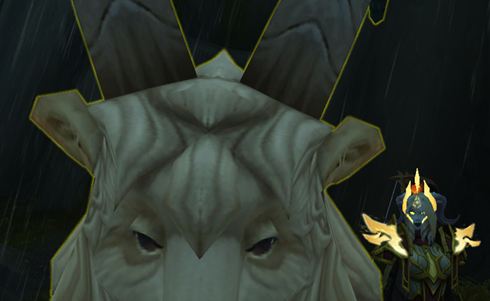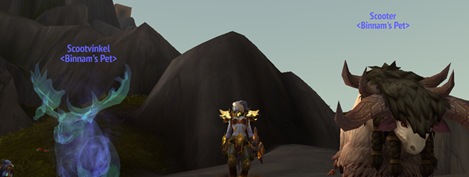Waiting for Bulvinkel: World of Warcraft and Addiction, Habit or Something Else?
“I am a patient boy. I wait, I wait, I wait, I wait… (for Bulvinkel)”
-Fugazi’s “Waiting Room,” 13 Songs, 1989.
In the leadup to the release of World of Warcraft’s latest expansion I found myself experimenting with new classes. I gravitated towards the hunter, a class that has the ability to tame the wild beasts that roam WoW’s wilderness. While there are a bunch of common animals ready for the taming, there are a few of exotic pets that a hunter can tame. Not satisfied with my common yak, one of these exotic companions-to-be caught my eye: a transparent spectral moose named Bulvinkel. When I saw Bulvinkel with other hunters I was envious and realized that I needed a Bulvinkel of my own. I did some research and found out that he lived atop a rainy mountain peak in the viking-inspired Stormheim region.
It wasn’t a monumental task to get there so it became my in-game priority. I took a couple magic portals, a bird-ride, then galloped up the side of a mountain to find Bulvinkel’s home, a small ledge occupied by goats.
Figure 1. The goats have seen people like me before, and they’ll see people like me again.
So many goats, and not a single moose among them. It turns out that Bulvinkel was a hot commodity for hunters the world (of warcraft) over, and that once he was killed or tamed by another hunter he would only respawn in the world once every couple hours. “What’s a couple hours?” I thought to myself. So I set up shop on the ledge and waited…
…and waited. For quite some time. At some point I got up from my PC to get a snack and when I came back to the screen everything was mostly the same. Or was it? The goats were there, the moose was still absent but - in my absence could the moose have come and gone, and more importantly, did my wait begin again? The only way to know for sure was, well, to wait. And so I waited…
…and waited. Sometimes whole days would pass without seeing the moose because I would step away from the screen, close the game and do other seemingly more important things. But when I logged in, my character would still be there on that ledge. While working I would run WoW in the background of my PC. Intermittently I would check back in to see if Bulvinkel had appeared, but I felt like I was frequently in a space of not knowing. Was he close to appearing? Had I just missed him while I was typing something up? After a few days I was there when he appeared to me for the first time, but in the moment it took to target Bulvinkel and press the ‘tame’ button, another player had scooped Bulvinkel from my grasp. This player had wandered over to the ledge only minutes before. Coincidence or conspiracy? Who can know for sure? As they left with a Bulvinkel of their own in tow, I knew I would need to do more. While I devised a strategy to avoid this crushing failure after feeling the slightest sliver of hope, I did what anyone would do. I waited…
…and waited. I created a macro, a combination of actions that would make it faster for me to target and tame Bulvinkel again, should he grace my lonely ledge with his presence once more. Not one to miss another opportunity, if I had to step away from the PC I would ask one of my roommates if they could babysit my computer and watch the ledge while I stepped out of the room. I directed them to the key that would trigger the macro I made. “If you see a glowing blue moose,” I told them, “just press this button as fast as you can.” At my request they diligently kept their gaze on the screen, eyes open for a moosey needle in a goatstack, but it was to no avail. So I waited…
…and waited. While I was waiting this time I found a mod, an addition to the game that modifies elements of the user interface. This particular mod would announce to you if a rare NPC like Bulvinkel appeared in your vicinity. I installed it and configured it to chime only when Bulvinkel appeared, but not once in the days of my wait did the mod ever ring out. Even worse, when I was distracted and looking at the menu to fix this broken chime, Bulvinkel must have appeared, for one of the other hunters on the ledge had a new Bulvinkel with them when I exited the menu. Another defeat. I was driven to conduct some research to see if I could gain an even greater edge, or find something to increase my odds of being the next one to befriend the ‘Vinkel. Online there was some discussion that after the servers reset, these rare creatures started spawning into the world, so I waited until the servers reset and logged in, but each time this happened, alas, there was no Bulvinkel. Either this information was untrue, or maybe the sad reality was that I was just too slow. Despite my commitment, I wasn’t committed enough. And so again, with brooding intensity, I waited… and waited… and waited.
The way I integrated my wait for Bulvinkel into my life brought to mind questions about the obsessive ways we play. Addiction is the go-to term for thinking about this kind of compulsive activity. Addiction studies are consistently supported across multiple research fields and the concept has been in wide circulation among the general public for decades, so it’s no wonder we’re so quick to use the term whenever we find ourselves repeatedly drawn to certain activities. We shouldn’t dismiss addiction as a way of understanding our most intense relationships to activities and substances, but our eagerness to deploy addiction as a blanket term creates a blind spot to all the other meanings these obsessive moments in gaming can have. Overusing the term ‘addiction’ can also numb us to the severity of actual addictions and the impact they can have on people’s lives and implies that the possible causes and treatments for these activities are the same. Jumping to addiction as the conclusion isn’t doing anyone any favours.
An alternative way of thinking about these activities are as habits. The authors of Habits: Remaking Addiction argue for a move away from ‘addiction’ to ‘habit,’ in part because ‘habit’ as a term reconsiders currently stigmatized consumption acts (ie. overeating, too much gaming or social media use) as part of everyday life (Fraser et al., 2014). These activities may not necessarily be morally good or healthy, but they are to some degree completely expected given the way our lives and society are presently organized. Moving towards habit from addiction opens up our thinking about recurring activities to a wider range of explanations.
My brief but intense affair with Bulvinkel and the goats didn’t feel like a habit for me, although I imagine it could be a gameplay loop that has a habit-forming structure for some players. Once my sojourn with Bulvinkel ended I didn’t gravitate to another ledge or apply those new play patterns to other facets of the game. If we zoom out though, games are part of my daily routine, time permitting, and so I was doing something that wasn’t a habit within part of my life that is admittedly habitual. While my days on the goat ledge may have been nested in addictive or habitual tendencies, my Bulvinkling activities themselves aren’t reducible to addiction or habit. There was immediacy, intensity, and a strange deviation from my regular play patterns to what I was doing in this game: it produced strong feelings in me and a way of playing that we don’t think about when we consider what drives people to play, and what keeps many of us coming back, whether we play in what could be considered clinically healthy or unhealthy amounts. My time on the ledge, as intense as it had been, was also temporary. There are missing pieces somewhere in the discussion of addiction, habituation, and lesser-appreciated forms of highly-invested gameplay that can better explain these moose-induced spasms of intensity.
We can think about these levels of intensity in play and their meaning beyond their moral position as socially good or bad, and consider the range of personal and interpersonal resonances that these experiences create. Did I need to acquire this moose to show off my Bulvinkel to others? Was I there because of the unanticipated interactions life on the ledge could lead to?
Figure 2. Another hunter and I reassure one another that we’ll catch Bulvinkel one day, after we both miss the beast.
Was Bulvinkel the perfect distraction from the ever-looming pandemic, chronic overwork, and the other gameplay patterns common to my chosen passtime? What drove everyone with a Bulvinkel of their own to befriend this majestic spirit, and what, if anything, did those moments and that moose do for them? Every Bulvinkel is a journey, after all!
There’s a lot more to understand about what games do for us and to us. We should keep ourselves open to new understandings of even our most compulsive play tendencies by resisting the urge to slap everything we play or analyze with the addiction label. My strategy: the next time I off-handedly claim that someone (myself included!) is addicted to a game, I will stop myself and think, “No, we’re not addicted to games, we’re Bulvinkeled to them.” Among what new and unfamiliar goats may we find ourselves with an outlook like that?
In case you’re wondering, I did eventually tame Bulvinkel. After waking up at my usual hour and checking my morning emails, I booted WoW while I made breakfast. I came back and saw my character on the ledge. There wasn’t a single other player around me - but there he was, surrounded by the foulest array of goatkind: Bulvinkel. In a moment of total calm I sat down at my desk, took a bite of my thoroughly passable oatmeal, walked my character over and tamed the beast as though it had been the easiest thing in the world. And then I went and did something else.
Figure 3. Got him! Just in time to never play this character again.
“Me: Let’s go.
Also Me: We can’t
Me: Why not?
Accursed Me: We’re waiting for Bulvinkel.”
-Exactly what Samuel Beckett was anticipating when he wrote Waiting for Godot
REFERENCES
Suzanne Fraser, David Moore and Hele Keane, Habits: Remaking Addiction, New York: Palgrave MacMillan, 2014.




